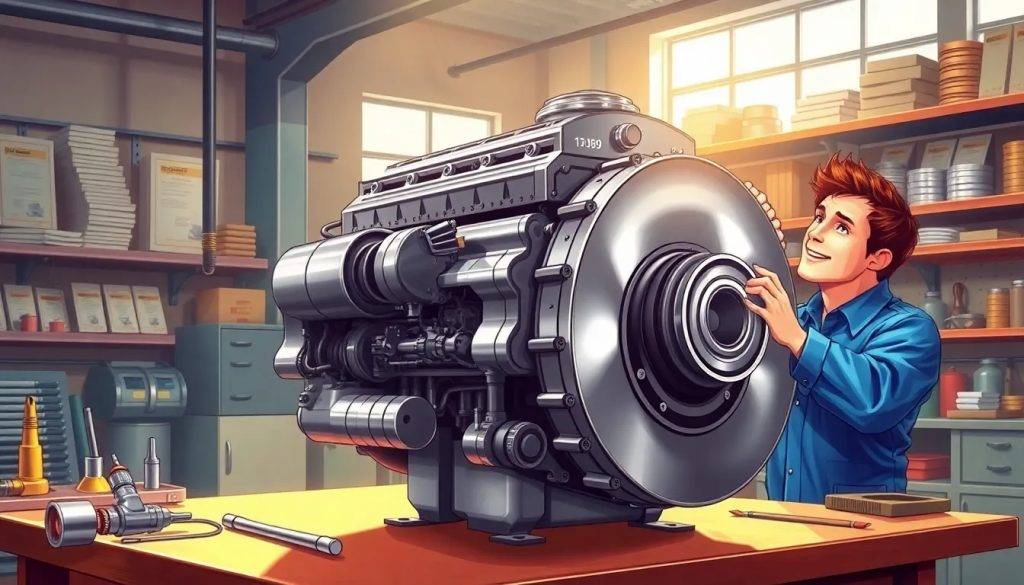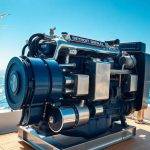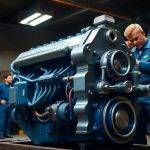Detroit diesel 2 stroke engine specs

Detroit Diesel has long been synonymous with robust performance and reliability, especially in the realm of two-stroke engines. These engines have carved out a legacy of strength and efficiency, making them popular in various applications, from industrial to marine sectors.
The two primary series—Series 71 and Series 92—have defined the standard for diesel engines for decades. In this article, we'll delve into the specifications of Detroit Diesel 2 stroke engines, their features, and how they stand out in the market.
- What are the key features of Detroit Diesel 2 stroke engines?
- How does the Detroit Diesel Series 71 compare to the Series 92?
- What are the different models of Detroit Diesel 2 stroke engines?
- What applications are best suited for Detroit Diesel 2 stroke engines?
- What is the power output range for Detroit Diesel 2 stroke engines?
- What innovations were introduced in the Detroit Diesel Series 92?
- Related questions about Detroit Diesel 2 stroke engines
What are the key features of Detroit Diesel 2 stroke engines?
The Detroit Diesel 2 stroke engines are known for their unique engineering and efficient performance. One of the standout features is their design simplicity, which allows for easier maintenance compared to four-stroke engines.
Another key feature is their high power-to-weight ratio, enabling them to deliver substantial power without the added bulk. The engines function on a two-stroke cycle, which allows for a power stroke with every rotation of the crankshaft, enhancing their efficiency further.
Additionally, many models in this series utilize a V-block configuration, which not only aids in compact design but also contributes to improved balance during operation.
How does the Detroit Diesel Series 71 compare to the Series 92?
The Detroit Diesel Series 71 and Series 92 are both iconic, but they differ significantly in design and application. The Series 71 was produced from 1938 to 1995 and is characterized by its inline and V configurations. It features a displacement of 71 cubic inches per cylinder, making it notable for durability and versatility.
In contrast, the Series 92, introduced in 1974, offers a broader range of configurations, including V6 to V16 models, catering to a wider array of power outputs, which range from 253 to over 1500 horsepower. This series is engineered for enhanced performance and efficiency, making it suitable for more demanding applications.
Moreover, the Series 92 incorporates several innovations over the Series 71, including improved turbocharging capabilities that boost overall performance without compromising fuel efficiency.
What are the different models of Detroit Diesel 2 stroke engines?
The Detroit Diesel 2 stroke engine lineup includes various models, each tailored for specific applications. Here are some notable models:
- Series 71: Known for its robustness and versatility, often used in military and marine applications.
- Series 92: Offers a wide range of options in terms of power output and configuration, suitable for heavy-duty applications.
- Series 53: Smaller than the Series 71, often found in light-duty applications and known for its efficiency.
- Series 60: While primarily a four-stroke engine, it showcases the evolution of Detroit Diesel engineering.
These models reflect the brand's commitment to providing solutions across diverse sectors, from construction to transportation.
What applications are best suited for Detroit Diesel 2 stroke engines?
Detroit Diesel 2 stroke engines have been employed across a vast range of applications due to their adaptability and performance. Some of the most common applications include:
- Marine propulsion: Ideal for boats and ships, providing reliable power in harsh marine environments.
- Industrial equipment: Frequently used in generators and heavy machinery, where durability is paramount.
- Military vehicles: Their robustness makes them a preferred choice for military applications, including armored vehicles.
- Transportation: Utilized in buses and trucks for their efficiency and power.
The versatility of these engines allows them to meet the demanding requirements of various industries effectively.
What is the power output range for Detroit Diesel 2 stroke engines?
The power output of Detroit Diesel 2 stroke engines varies widely depending on the model and configuration.
- The Series 71 typically ranges from 60 to 400 horsepower, making it suitable for lighter applications.
- The Series 92, on the other hand, can produce from 253 to over 1500 horsepower, catering to much heavier demands.
This range of power ratings ensures that there is a Detroit Diesel engine model for nearly every operational need, from smaller vessels to large industrial machines.
What innovations were introduced in the Detroit Diesel Series 92?
The Detroit Diesel Series 92 introduced several key innovations that enhanced its performance and efficiency. One of the most significant advancements was the incorporation of turbocharging, allowing the engine to deliver higher power outputs without significantly increasing its size or weight.
Another innovation was the development of improved fuel injection systems, which optimized fuel efficiency and reduced emissions. These enhancements made the Series 92 not only more powerful but also more environmentally friendly compared to its predecessors.
Additionally, the Series 92 featured improved cooling systems that helped maintain optimal operating temperatures, further enhancing its reliability during heavy-duty operations.
How much horsepower does a Detroit Diesel 2-stroke have?
The horsepower of a Detroit Diesel 2-stroke engine varies significantly based on the specific model. The Series 71, for instance, generally produces between 60 to 400 horsepower. In contrast, the Series 92 offers a much wider range, with outputs starting at 253 horsepower and exceeding 1500 horsepower for larger configurations. This range caters to both light and heavy-duty applications, ensuring that operators can find an engine that meets their specific power needs.
When was the last 2-stroke Detroit Diesel made?
Production of the Detroit Diesel two-stroke engines gradually declined in the late 1990s, with the last units being produced around 1995 for the Series 71. Since then, the focus has shifted toward more modern engine designs, including four-stroke engines that offer advanced efficiency and reduced emissions. However, the legacy of the two-stroke engines continues to be felt in various applications where they remain in operation.
What is the difference between the Detroit Diesel Series 71 and 92?
The primary differences between the Detroit Diesel Series 71 and Series 92 lie in their configurations and power outputs. The Series 71 features both inline and V configurations and is known for its durability and simplicity. In contrast, the Series 92 offers a wider range of configurations, from V6 to V16, along with higher power outputs, making it suitable for more demanding applications. Moreover, the Series 92 incorporates advanced technology such as turbocharging, improving efficiency and performance over its predecessor.
What makes a Detroit Diesel 2-stroke?
A Detroit Diesel engine is classified as a two-stroke engine due to its operational mechanics, which allow it to complete a power cycle in just two strokes of the piston. This design enables the engine to produce power more frequently compared to four-stroke engines, making it more efficient in certain applications. The two-stroke cycle involves processes of scavenging and compression that facilitate the rapid expulsion of exhaust gases while drawing in a fresh air-fuel mixture. This unique operation contributes to the characteristic power and efficiency of Detroit Diesel two-stroke engines.
 Detroit diesel engine manufacturing plant
Detroit diesel engine manufacturing plant Detroit 353 diesel engine overview
Detroit 353 diesel engine overview 8.2 liter detroit diesel marine engine overview
8.2 liter detroit diesel marine engine overview Detroit diesel engine 71: everything you need to know
Detroit diesel engine 71: everything you need to knowIf you want to know other articles similar to Detroit diesel 2 stroke engine specs you can visit the category DETROIT.
Leave a Reply

RELATED POSTS